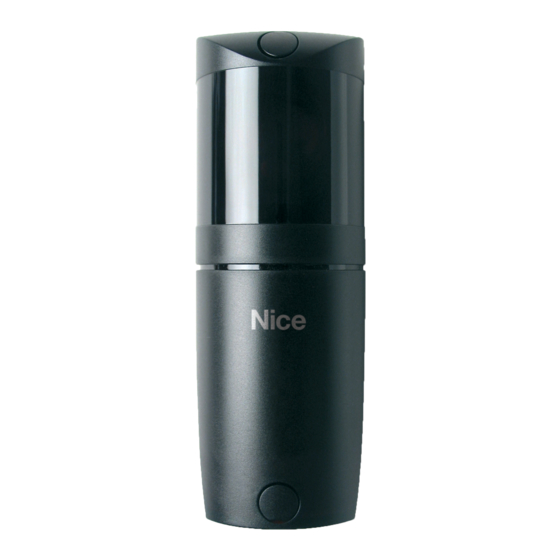Advertisement
Testing of automation with FT210B optical device
In conformity with the Machinery Directive 2006/42/EC and applicable parts of the EN standards EN 13241-1; EN 12453; EN 12445; EN 12635
Caution: testing of the entire system must be performed by skilled and qualified personnel, who are responsible for the tests
required, according to the risk present, and for ensuring observance of all legal provisions, standards and regulations, and in
particular all requirements of the standard EN 12445, which establishes the test methods for checking automations for doors and
gates.
Each individual component of the automation system requires a specific testing phase.
Perform the following sequence of operations for the testing of the F210B.
The sequence is repeated for each device in the event 2 devices are present, one on the front of the gate and one on the back of
the gate.
Warning: some points require that the gate is in movement for the control; as the automation MAY not be adequately SAFE, the
maximum attention must be given during these controls.
1.
Make sure that all that is foreseen in the present manual, in particular chapters
"Warnings" and "Installation" is fully abided by.
2.
Release and fully open the gate leaf so that the TX is at the maximum possible
distance from the RX.
3.
Make sure that there are no obstacles between the Tx and the RX.
4.
If already connected, disconnect the receiver from the "BlueBUS" and remove
the battery from the transmitter.
5.
Disconnect the sensitive device from the TX terminals and measure the
resistance of the device with an ohmmeter, checking that the value is between
7700Ω and 8700Ω (nominal 8200Ω).
6.
Push the sensitive edge to activate it and measure once again the resistance.
Check that the resistance is lower than 1000Ω or higher than 16500Ω.
7.
Reconnect the sensitive device to the TX terminals.
8.
Reconnect the receiver to the "BlueBUS" and perform the recognition of the
devices connected to the "BlueBUS" from the control unit.
9.
Check that the L1 (Ir Level) L2 (Phototest Ko) and L3 (Sensitive Device Ko)
LEDs are on. Check that the L4 LED (Sensitive Device Ok) is off (see figure 1).
10.
Remove the JP3 jumper on the TX so that it always transmits in the FAST mode.
11.
If the distance between the TX and the RX exceeds 7 m check that the JP1
jumper on the TX is connected (this meaningprogrammed for distances up to 15 m).
12.
Insert the FTA1 or FTA2 battery into the TX.
13.
Check that the L1 (Ir level) LED on the RX receiver flashes; the L2 (Phototest
Ko) LED and the L4 (Sensitive device Ok) LEDs are on and that the L3 ((Sensitive
device Ko) LED is off.
14.
If necessary, improve the alignment by directing the TX and RX lenses as shown
in figure 2. By performing the L1 (Ir level) LED signal the speed of the flashing is less
and the alignment is greater. The adjustment is at its best when the LED flashes
slowly at a maximum of 3 flashes a second.
15.
Repeat the test placing the top protection covers both on TX and RX. Note that
the RX cover is fitted with a damper filter that simulates adverse weather conditions
which could arise during use.
16.
Move the gate leaf along the entire course and check, through the flashes of the
L1 LED, that the alignment remains above the optimum.
17.
To check the optical presence sensor (type D) of the FT210B, and to make sure
that there is no interference with other devices, pass a 50 mm diameter cylinder
across the optical axis, first near the TX, then near the RX and finally between the
two (see figure 3) and make sure that in all cases the device is triggered, switching
from the active status to the alarm status (LED L1 ON) and vice versa.
18.
To check the PSPE pressure sensitive device of the FT210B, push and release
the sensitive edge as shown in figure 4 and check that the L4 LED turns off and that
the L3 LED turns on and vice versa.
19.
If this is the preferred program, connect the JP3 jumper on the TX so that the
transmission changes over to SLOW a few seconds after the movement has
finished.
20.
If the operation in the previous point has been performed; check that the
transmitter changes over to SLOW after the foreseen time has past. The
transmission in the SLOW mode can be recognised through four short flashes of
the L1 LED followed by a pause.
21.
Mechanically connect the leaf to the motor and perform a manoeuvre of the
gate. In the meantime, check that the L2 LED turns off at the beginning of the
manoeuvre, indicating that the vibration sensor test of the moving gate has been
performed correctly.
Document produced by Nice S.p.a. for installers – All rights reserved
Fig.1
Fig.2
Fig.3
Fig.4
Page ____ of ______
Enclosure
C.50
Rev 4.00
01/09/2010
Advertisement
Table of Contents

Summary of Contents for Nice FT210B
- Page 1 Move the gate leaf along the entire course and check, through the flashes of the L1 LED, that the alignment remains above the optimum. To check the optical presence sensor (type D) of the FT210B, and to make sure that there is no interference with other devices, pass a 50 mm diameter cylinder...
- Page 2 5 and according to chapter 7 of the EN 12445:2000 standard. The control of the PSPE pressure sensitive device of the FT210B according to the EN 12445 standard, is performed by measuring the force...


Need help?
Do you have a question about the FT210B and is the answer not in the manual?
Questions and answers